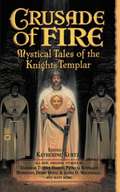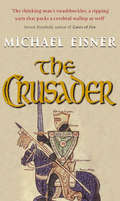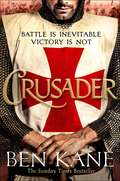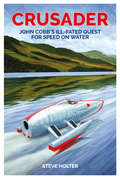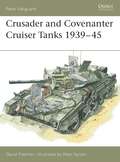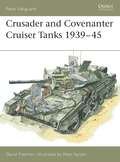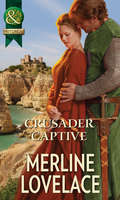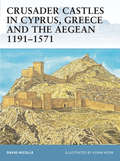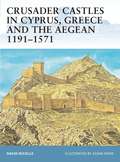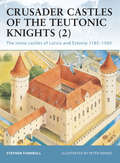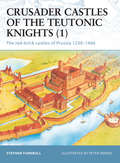- Table View
- List View
Crusade and Mission: European Approaches Toward the Muslims (PDF)
by Benjamin Z. KedarThis wide-ranging study of medieval Europe's response to the challenge of Islam examines the relationship between ideas of crusade and mission, between European projects for military conquest and those for the conversion of Muslims to Christianity. Covering the years from the emergence of Islam to the fourteenth century, Benjamin Z. Kedar discusses not only the crusades and the Crusading Kingdom of Jerusalem but also the confrontation of Catholics and Muslims in Sicily and Spain.Originally published in 1984.The Princeton Legacy Library uses the latest print-on-demand technology to again make available previously out-of-print books from the distinguished backlist of Princeton University Press. These editions preserve the original texts of these important books while presenting them in durable paperback and hardcover editions. The goal of the Princeton Legacy Library is to vastly increase access to the rich scholarly heritage found in the thousands of books published by Princeton University Press since its founding in 1905.
Crusade for Justice: The Autobiography of Ida B. Wells, Second Edition (Negro American Biographies and Autobiographies)
by Ida B. Wells“She fought a lonely and almost single-handed fight, with the single-mindedness of a crusader, long before men or women of any race entered the arena; and the measure of success she achieved goes far beyond the credit she has been given in the history of the country.”—Alfreda M. Duster Ida B. Wells is an American icon of truth telling. Born to slaves, she was a pioneer of investigative journalism, a crusader against lynching, and a tireless advocate for suffrage, both for women and for African Americans. She co-founded the NAACP, started the Alpha Suffrage Club in Chicago, and was a leader in the early civil rights movement, working alongside W. E. B. Du Bois, Madam C. J. Walker, Mary Church Terrell, Frederick Douglass, and Susan B. Anthony. This engaging memoir, originally published 1970, relates Wells’s private life as a mother as well as her public activities as a teacher, lecturer, and journalist in her fight for equality and justice. This updated edition includes a new foreword by Eve L. Ewing, new images, and a new afterword by Ida B. Wells’s great-granddaughter, Michelle Duster.
Crusade for Justice: The Autobiography of Ida B. Wells, Second Edition (Negro American Biographies and Autobiographies)
by Ida B. Wells“She fought a lonely and almost single-handed fight, with the single-mindedness of a crusader, long before men or women of any race entered the arena; and the measure of success she achieved goes far beyond the credit she has been given in the history of the country.”—Alfreda M. Duster Ida B. Wells is an American icon of truth telling. Born to slaves, she was a pioneer of investigative journalism, a crusader against lynching, and a tireless advocate for suffrage, both for women and for African Americans. She co-founded the NAACP, started the Alpha Suffrage Club in Chicago, and was a leader in the early civil rights movement, working alongside W. E. B. Du Bois, Madam C. J. Walker, Mary Church Terrell, Frederick Douglass, and Susan B. Anthony. This engaging memoir, originally published 1970, relates Wells’s private life as a mother as well as her public activities as a teacher, lecturer, and journalist in her fight for equality and justice. This updated edition includes a new foreword by Eve L. Ewing, new images, and a new afterword by Ida B. Wells’s great-granddaughter, Michelle Duster.
Crusade for Justice: The Autobiography of Ida B. Wells, Second Edition (Negro American Biographies and Autobiographies)
by Ida B. Wells“She fought a lonely and almost single-handed fight, with the single-mindedness of a crusader, long before men or women of any race entered the arena; and the measure of success she achieved goes far beyond the credit she has been given in the history of the country.”—Alfreda M. Duster Ida B. Wells is an American icon of truth telling. Born to slaves, she was a pioneer of investigative journalism, a crusader against lynching, and a tireless advocate for suffrage, both for women and for African Americans. She co-founded the NAACP, started the Alpha Suffrage Club in Chicago, and was a leader in the early civil rights movement, working alongside W. E. B. Du Bois, Madam C. J. Walker, Mary Church Terrell, Frederick Douglass, and Susan B. Anthony. This engaging memoir, originally published 1970, relates Wells’s private life as a mother as well as her public activities as a teacher, lecturer, and journalist in her fight for equality and justice. This updated edition includes a new foreword by Eve L. Ewing, new images, and a new afterword by Ida B. Wells’s great-granddaughter, Michelle Duster.
Crusade for Justice: The Autobiography of Ida B. Wells, Second Edition (Negro American Biographies and Autobiographies)
by Ida B. Wells“She fought a lonely and almost single-handed fight, with the single-mindedness of a crusader, long before men or women of any race entered the arena; and the measure of success she achieved goes far beyond the credit she has been given in the history of the country.”—Alfreda M. Duster Ida B. Wells is an American icon of truth telling. Born to slaves, she was a pioneer of investigative journalism, a crusader against lynching, and a tireless advocate for suffrage, both for women and for African Americans. She co-founded the NAACP, started the Alpha Suffrage Club in Chicago, and was a leader in the early civil rights movement, working alongside W. E. B. Du Bois, Madam C. J. Walker, Mary Church Terrell, Frederick Douglass, and Susan B. Anthony. This engaging memoir, originally published 1970, relates Wells’s private life as a mother as well as her public activities as a teacher, lecturer, and journalist in her fight for equality and justice. This updated edition includes a new foreword by Eve L. Ewing, new images, and a new afterword by Ida B. Wells’s great-granddaughter, Michelle Duster.
The Crusade in the Fifteenth Century: Converging and competing cultures (Crusades - Subsidia)
by Norman HousleyIncreasingly, historians acknowledge the significance of crusading activity in the fifteenth century, and they have started to explore the different ways in which it shaped contemporary European society. Just as important, however, was the range of interactions which took place between the three faith communities which were most affected by crusade, namely the Catholic and Orthodox worlds, and the adherents of Islam. Discussion of these interactions forms the theme of this book. Two essays consider the impact of the fall of Constantinople in 1453 on the conquering Ottomans and the conquered Byzantines. The next group of essays reviews different aspects of the crusading response to the Turks, ranging from Emperor Sigismund to Papal legates. The third set of contributions considers diplomatic and cultural interactions between Islam and Christianity, including attempts made to forge alliances of Christian and Muslim powers against the Ottomans. Last, a set of essays looks at what was arguably the most complex region of all for inter-faith relations, the Balkans, exploring the influence of crusading ideas in the eastern Adriatic, Bosnia and Romania. Viewed overall, this collection of essays makes a powerful contribution to breaking down the old and discredited view of monolithic and mutually exclusive "fortresses of faith". Nobody would question the extent and intensity of religious violence in fifteenth-century Europe, but this volume demonstrates that it was played out within a setting of turbulent diversity. Religious and ethnic identities were volatile, allegiances negotiable, and diplomacy, ideological exchange and human contact were constantly in operation between the period's major religious groupings.
The Crusade in the Fifteenth Century: Converging and competing cultures (Crusades - Subsidia)
by Norman HousleyIncreasingly, historians acknowledge the significance of crusading activity in the fifteenth century, and they have started to explore the different ways in which it shaped contemporary European society. Just as important, however, was the range of interactions which took place between the three faith communities which were most affected by crusade, namely the Catholic and Orthodox worlds, and the adherents of Islam. Discussion of these interactions forms the theme of this book. Two essays consider the impact of the fall of Constantinople in 1453 on the conquering Ottomans and the conquered Byzantines. The next group of essays reviews different aspects of the crusading response to the Turks, ranging from Emperor Sigismund to Papal legates. The third set of contributions considers diplomatic and cultural interactions between Islam and Christianity, including attempts made to forge alliances of Christian and Muslim powers against the Ottomans. Last, a set of essays looks at what was arguably the most complex region of all for inter-faith relations, the Balkans, exploring the influence of crusading ideas in the eastern Adriatic, Bosnia and Romania. Viewed overall, this collection of essays makes a powerful contribution to breaking down the old and discredited view of monolithic and mutually exclusive "fortresses of faith". Nobody would question the extent and intensity of religious violence in fifteenth-century Europe, but this volume demonstrates that it was played out within a setting of turbulent diversity. Religious and ethnic identities were volatile, allegiances negotiable, and diplomacy, ideological exchange and human contact were constantly in operation between the period's major religious groupings.
Crusade of Fire: Mystical Tales of the Knights Templar
by Katherine KurtzLegend holds that their alliance was formed in A.D. 1119 in order to protect pilgrims in the Holy Land. Later they came to be known as the warrior elite of Christiandom. But because of their intense secrecy, many debated whether the Knights Templar were the embodiment of divine good—or the incarnation of evil. Here, the bestselling author/editor who brought readers Tales of the Knights Templar and On Crusade: More Tales of the Knights Templar returns with another brilliant collection of original stories by some of fantasy fiction&’s best and brightest authors about the mystical legends surrounding the Knights Templar.
The Crusade of Frederick Barbarossa: The History of the Expedition of the Emperor Frederick and Related Texts (Crusade Texts in Translation)
by G. A. LoudThis is the first English translation of the main contemporary accounts of the Crusade and death of the German Frederick I Barbarossa (ruled 1152-90). The most important of these, the 'History of the Expedition of the Emperor Frederick' was written soon after the events described, and is a crucial, and under-used source for the Third Crusade (at least in the Anglophone world). The account begins with two letters describing the disaster of Hattin and Saladin's subsequent conquest of most of the Holy Land (the second of these is addressed to the duke of Austria). It goes on to describe how the emperor took the Cross, the preparations and recruitment for the Crusade, the diplomatic contacts of Barbarossa with the Byzantine Emperor and the Sultan of Iconium in an attempt to secure a peaceful passage for the expedition, and the Crusade itself: the journey through the Balkans and the gruelling march through Asia Minor, beset by Turkish attack, until its arrival at Antioch on 21st July 1190, eleven days after the emperor had drowned while crossing a river in Cilician Armenia. The 'History' gives a vivid account of the sufferings of the German army as it traversed Asia Minor. The account of the expedition itself appears to be, or to be based upon an eyewitness record, cast in the form of (often) a daily memoir. However, it concludes with an account of the captivity and release of Richard I in Germany, Henry VI's conquest of the kingdom of Sicily, and of the preparations for a new Crusade under his leadership. In addition, a number of further accounts related to, and expanding, the 'History of the Expedition' have also been translated, including a contemporary newsletter about the death of the emperor, as well as the narrative of Otto of St Blasien, placing the Crusade into context twenty years later, and a contemporary account of the capture of Silves in Portugal by German crusaders on their way to the Holy Land in 1189. This collection is a valuable companion volume to the three other volumes relating to the Third Crusade in this series: The Conquest of Jerusalem and the Third Crusade, trans. Edbury, the Itinerarium Peregrinorum et Gesta Regis Ricardi, trans. Nicholson, and The Rare and Excellent History of Saladin, trans. Richards.
The Crusade of Frederick Barbarossa: The History of the Expedition of the Emperor Frederick and Related Texts (Crusade Texts in Translation)
by G. A. LoudThis is the first English translation of the main contemporary accounts of the Crusade and death of the German Frederick I Barbarossa (ruled 1152-90). The most important of these, the 'History of the Expedition of the Emperor Frederick' was written soon after the events described, and is a crucial, and under-used source for the Third Crusade (at least in the Anglophone world). The account begins with two letters describing the disaster of Hattin and Saladin's subsequent conquest of most of the Holy Land (the second of these is addressed to the duke of Austria). It goes on to describe how the emperor took the Cross, the preparations and recruitment for the Crusade, the diplomatic contacts of Barbarossa with the Byzantine Emperor and the Sultan of Iconium in an attempt to secure a peaceful passage for the expedition, and the Crusade itself: the journey through the Balkans and the gruelling march through Asia Minor, beset by Turkish attack, until its arrival at Antioch on 21st July 1190, eleven days after the emperor had drowned while crossing a river in Cilician Armenia. The 'History' gives a vivid account of the sufferings of the German army as it traversed Asia Minor. The account of the expedition itself appears to be, or to be based upon an eyewitness record, cast in the form of (often) a daily memoir. However, it concludes with an account of the captivity and release of Richard I in Germany, Henry VI's conquest of the kingdom of Sicily, and of the preparations for a new Crusade under his leadership. In addition, a number of further accounts related to, and expanding, the 'History of the Expedition' have also been translated, including a contemporary newsletter about the death of the emperor, as well as the narrative of Otto of St Blasien, placing the Crusade into context twenty years later, and a contemporary account of the capture of Silves in Portugal by German crusaders on their way to the Holy Land in 1189. This collection is a valuable companion volume to the three other volumes relating to the Third Crusade in this series: The Conquest of Jerusalem and the Third Crusade, trans. Edbury, the Itinerarium Peregrinorum et Gesta Regis Ricardi, trans. Nicholson, and The Rare and Excellent History of Saladin, trans. Richards.
Crusade of the Left: The Lincoln Battalion in the Spanish Civil War
by Robert RosenstoneBetween 1936 and 1938, some 3,000 young Americans sailed to France and crossed the Pyrenees to take part in the brutal civil war raging in Spain. Virtually all joined the International Brigades, formed under the auspices of the Soviet-led Comintern and largely directed by Communists. Yet a large number were not Communists; their activism was inspired by domestic and international crises of the 1930s, and colored by idealism.The men who went to Spain came out of a radical subculture that emerged from the Depression and the New Deal. Th is radicalism was a native plant, but it was nourished from abroad. In the thirties the menace of fascism seemed to be spreading like cancer across Europe, giving an international aspect to many domestic problems in the United States. To intellectuals, students, unionists, liberals, and leftists, the threat of fascism was so real that many came to believe that if it was not stopped in Spain, eventually they would have to take up arms against fascism at home.To understand the Americans who fought in the Spanish Civil War it is necessary to bury some of the shibboleths of cold war years. Dissidence in the United States occurs in response to perceptions of reality on this side of the Atlantic, not because of the wishes of men in the Soviet Union. Th e members of the Lincoln Battalion were genuine products of America, and their story is properly a page in American military and political history. From them, one can learn much about the world of the 1930s and perhaps even something about the potential of modern man for thought and action in time of crisis.
Crusade of the Left: The Lincoln Battalion in the Spanish Civil War
by Robert RosenstoneBetween 1936 and 1938, some 3,000 young Americans sailed to France and crossed the Pyrenees to take part in the brutal civil war raging in Spain. Virtually all joined the International Brigades, formed under the auspices of the Soviet-led Comintern and largely directed by Communists. Yet a large number were not Communists; their activism was inspired by domestic and international crises of the 1930s, and colored by idealism.The men who went to Spain came out of a radical subculture that emerged from the Depression and the New Deal. Th is radicalism was a native plant, but it was nourished from abroad. In the thirties the menace of fascism seemed to be spreading like cancer across Europe, giving an international aspect to many domestic problems in the United States. To intellectuals, students, unionists, liberals, and leftists, the threat of fascism was so real that many came to believe that if it was not stopped in Spain, eventually they would have to take up arms against fascism at home.To understand the Americans who fought in the Spanish Civil War it is necessary to bury some of the shibboleths of cold war years. Dissidence in the United States occurs in response to perceptions of reality on this side of the Atlantic, not because of the wishes of men in the Soviet Union. Th e members of the Lincoln Battalion were genuine products of America, and their story is properly a page in American military and political history. From them, one can learn much about the world of the 1930s and perhaps even something about the potential of modern man for thought and action in time of crisis.
Crusade: The Uses of a Word from the Middle Ages to the Present (Crusades - Subsidia)
by Benjamin. WeberThe word ‘crusade’ covers today a wide variety of meanings in most European languages. The link between these uses and the historical phenomenon labelled as ‘crusade’ by historians is often very narrow and particularly changing. Understanding the real meaning of the word ‘crusade’, its connotations and implications, and thus the conscious or unconscious intentions of its uses requires a precise knowledge of the historical evolutions of the word, from its first appearance in the 13th century until nowadays.This book offers the first comprehensive view of the historical construction of the meaning of the word ‘crusade’ through comparative perspectives from the Middle Ages to the 21st century. Its 11 articles, introduction and conclusion examine different uses of the word, in a single language or within a specific context, and analyse each of them as a different conceptualisation of the crusading phenomenon. The book explains the progressive widening of the meaning of the term, from a military expedition to Jerusalem to the most metaphorical uses. It demonstrates the differences between the connotations of the word in various languages and cultures and, thus, the variety of its possible uses. It insists on the reluctance and reticence that ‘crusade’ has always provoked since the Middle Ages, precisely because the conceptualisation it implied was not shared by all.The book will be of interest not only for crusade scholars and for diachronic linguists but also for anyone interested in understanding better modern discourses and references to the ‘crusade’ by politicians, activists, and journalists, through a precise inquiry on the historical developments of the word and the variety of its meanings.
Crusade: The Uses of a Word from the Middle Ages to the Present (Crusades - Subsidia)
by Benjamin WeberThe word ‘crusade’ covers today a wide variety of meanings in most European languages. The link between these uses and the historical phenomenon labelled as ‘crusade’ by historians is often very narrow and particularly changing. Understanding the real meaning of the word ‘crusade’, its connotations and implications, and thus the conscious or unconscious intentions of its uses requires a precise knowledge of the historical evolutions of the word, from its first appearance in the 13th century until nowadays.This book offers the first comprehensive view of the historical construction of the meaning of the word ‘crusade’ through comparative perspectives from the Middle Ages to the 21st century. Its 11 articles, introduction and conclusion examine different uses of the word, in a single language or within a specific context, and analyse each of them as a different conceptualisation of the crusading phenomenon. The book explains the progressive widening of the meaning of the term, from a military expedition to Jerusalem to the most metaphorical uses. It demonstrates the differences between the connotations of the word in various languages and cultures and, thus, the variety of its possible uses. It insists on the reluctance and reticence that ‘crusade’ has always provoked since the Middle Ages, precisely because the conceptualisation it implied was not shared by all.The book will be of interest not only for crusade scholars and for diachronic linguists but also for anyone interested in understanding better modern discourses and references to the ‘crusade’ by politicians, activists, and journalists, through a precise inquiry on the historical developments of the word and the variety of its meanings.
The Crusader
by Michael EisnerIn the latter half of the 13th century, Christian Europe again sought to prise the Holy Land out of the grasp of the Infidel. Tens of thousands took up the Cross - some for the greater glory of God, others for baser motives: lust for power, for riches, for revenge.THE CRUSADER tells the story of the seventh and last Crusade, as experienced by a young Spanish nobleman, Francisco de Montcada. He is the hero of this novel, but his tale is told by his former friend and a fellow acolyte, a venal and moderately trustworthy Cistercian monk named Brother Lucas. For Francisco has returned from the Levant a broken and seemingly possessed man. The Inquisition decree that his tortured soul be exorcized and the task falls to Brother Lucas. Eschewing the Inquisition's more usual methods, the monk sits with the silent, emaciated knight in his cell and talks to him. Slowly, tentatively, Francisco begins to recount his story - a tale of how an honourable man took up the Cross and found not the glory and redemption for which he'd yearned but instead unimaginable cruelty, barbarism and bloodshed. Set against a thrillingly authentic historical backdrop, this stirring novel of religious fervour and human passions, of greed and betrayal, and love and war, brings a tumultuous era brilliantly to life.
Crusader: The second thrilling instalment in the Lionheart series
by Ben Kane'Yet another of history's most brutal and dramatic chapters given the five-star Ben Kane treatment.' Paul FinchKING. POLITICIAN. WARRIOR. CONQUEROR.1189. Richard the Lionheart's long-awaited goal comes true as he is crowned King of England. Setting his own kingdom in order, he prepares to embark on a gruelling crusade to reclaim Jerusalem.With him on every step of the journey is Ferdia, his loyal Irish follower. Together they travel from southern France to Italy, to the kingdom of Sicily and beyond.Finally poised to sail to the Holy Land, Richard finds a bitter two-year-long siege awaiting him. And with it, the iconic Saracen leader responsible for the loss of Jerusalem, Saladin.No one can agree who should fill the empty throne of the Kingdom of Jerusalem and Saladin's huge army shadows Richard's every move. Conditions are brutal, the temperatures boiling, and on the dusty field of Arsuf, the Lionheart and his soldiers face their ultimate test...
Crusader
by Nigel TranterAlexander III of Scotland was just seven years old when he inherited thethrone. South of the border, England's King Henry III saw this as hischance to assert his paramountcy over the kingdom. At the age of ten,the boy was married to Henry's daughter.But through the hazards of power politics and dynastic marriage - oneman stood by the young monarch. Whether it was shooting wild geese,helping him escape from the prison-like confines of Edinburgh Castle orteaching him to stand up both to his ever-threatening Englishfather-in-law and the unending feuds of his own countrymen, David deLindsay of Luffness in East Lothian was Alexander's one true andconstant friend.But David's only wish was to be a crusader, a wish he was finally tofulfil when the boy became a man.The turbulent 13th century story of the child king Alexander III ofScotland and David de Lindsay of Luffness, his one true supporter, in anage of crusades and wars.
Crusader and Covenanter Cruiser Tanks 1939–45 (New Vanguard)
by Peter Sarson David FletcherThe Covenanter (which never saw active service) and Crusader Cruiser tanks were developed between 1939 and 1940. The Crusader first saw action in the North African desert in June 1941: its speed and sleek design made it a hard target to hit, and the tank was well-respected by the Afrikakorps for its velocity in combat. But its hurried development prior to World War II also made it prone to mechanical failure. This book examines the Covenanter and the many variants of the Crusader tank, detailing the designs, developments and disappointments of these infamous World War II tanks.
Crusader and Covenanter Cruiser Tanks 1939–45 (New Vanguard #Vol. 14)
by Peter Sarson David FletcherThe Covenanter (which never saw active service) and Crusader Cruiser tanks were developed between 1939 and 1940. The Crusader first saw action in the North African desert in June 1941: its speed and sleek design made it a hard target to hit, and the tank was well-respected by the Afrikakorps for its velocity in combat. But its hurried development prior to World War II also made it prone to mechanical failure. This book examines the Covenanter and the many variants of the Crusader tank, detailing the designs, developments and disappointments of these infamous World War II tanks.
The Crusader Armies: 1099†“1187
by Steve TibbleA major new history of the Crusades that illuminates the strength and sophistication of the Western and Muslim armies During the Crusades, the Western and Muslim armies developed various highly sophisticated strategies of both attack and defense, which evolved during the course of the battles. In this ambitious new work, Steve Tibble draws on a wide range of Muslim texts and archaeological evidence as well as more commonly cited Western sources to analyze the respective armies’ strategy, adaptation, evolution, and cultural diversity and show just how sophisticated the Crusader armies were even by today’s standards. In the first comprehensive account of the subject in sixty years, Tibble takes a fresh approach to Templars, Hospitallers, and other key Orders and makes the controversial proposition that the Crusades were driven as much by sedentary versus nomadic tribal concerns as by religious conflict. This fluently written, broad-ranging narrative provides a crucial missing piece in the study of the West’s attempts to colonize the Middle East during the Middle Ages.
Crusader Captive (Mills And Boon Historical Ser.)
by Merline LovelaceShoulders square, he stood with his feet spread as far as his leg irons would allow and looked out with disdain
Crusader Castles in Cyprus, Greece and the Aegean 1191–1571 (Fortress #59)
by Mr Adam Hook Dr David NicolleThe castles built by the Crusaders, Hospitallers, Venetians and Genoese in Cyprus, Greece, the Aegean, and on the Black Sea served to defend against a complex array of constantly changing threats: Mamluks, Catalan mercenaries, Ottoman Turks, Byzantines, independent Islamic states, Timur-i-Lenk, and widespread piracy, to name but few. The resulting fortifications some inherited from conquered the territories of the former Byzantine empire, some built from scratch were very different to those found in the Middle East. This superbly illustrated book explores their design, development and fate in detail, documenting the rich architectural heritage of this region and its complex history.
Crusader Castles in Cyprus, Greece and the Aegean 1191–1571 (Fortress)
by David Nicolle Adam HookThe castles built by the Crusaders, Hospitallers, Venetians and Genoese in Cyprus, Greece, the Aegean, and on the Black Sea served to defend against a complex array of constantly changing threats: Mamluks, Catalan mercenaries, Ottoman Turks, Byzantines, independent Islamic states, Timur-i-Lenk, and widespread piracy, to name but few. The resulting fortifications some inherited from conquered the territories of the former Byzantine empire, some built from scratch were very different to those found in the Middle East. This superbly illustrated book explores their design, development and fate in detail, documenting the rich architectural heritage of this region and its complex history.
Crusader Castles of the Teutonic Knights: The stone castles of Latvia and Estonia 1185–1560 (Fortress #19)
by Peter Dennis Dr Stephen TurnbullALSO AVAILABLE TO BUY AS AN E-BOOK. The original forced conversion of pagan Livonia, what is now the Baltic states of Latvia and Estonia, was carried out by a military order known as the Brethren of the Sword. In 1236 this order was incorporated into the Teutonic Knights following a catastrophic military defeat. The knights had always consolidated their conquests through networks of castles and fortified places, and the Livonian Chapter of the Teutonic Order built castles of stone. This title covers the developmental and operational history of these fortresses over the length of the Middle Ages. It details how the Baltic fortifications of the Teutonic Knights evolved to reflect the changing nature of siege warfare and the increasing dominance of gunpowder in warfare.
Crusader Castles of the Teutonic Knights: The red-brick castles of Prussia 1230–1466 (Fortress #11)
by Peter Dennis Dr Stephen TurnbullALSO AVAILABLE TO BUY AS AN E-BOOK. Throughout their stormy history the Teutonic Knights of Germany have always been the most controversial brotherhood ever to call themselves 'Knights of Christ'.They were the most warlike of the religious orders, and this is reflected in the architecture they left behind. In contrast to the Templars who are remembered for their churches, the Teutonic memorials are the magnificent brick-built castles they built as a result of their conquest of Prussia between 1230 and 1380. Many of these dramatic fortresses still exist today in what is now Poland and provide a unique example of an architectural style that closely reflects the nature of the Order.



